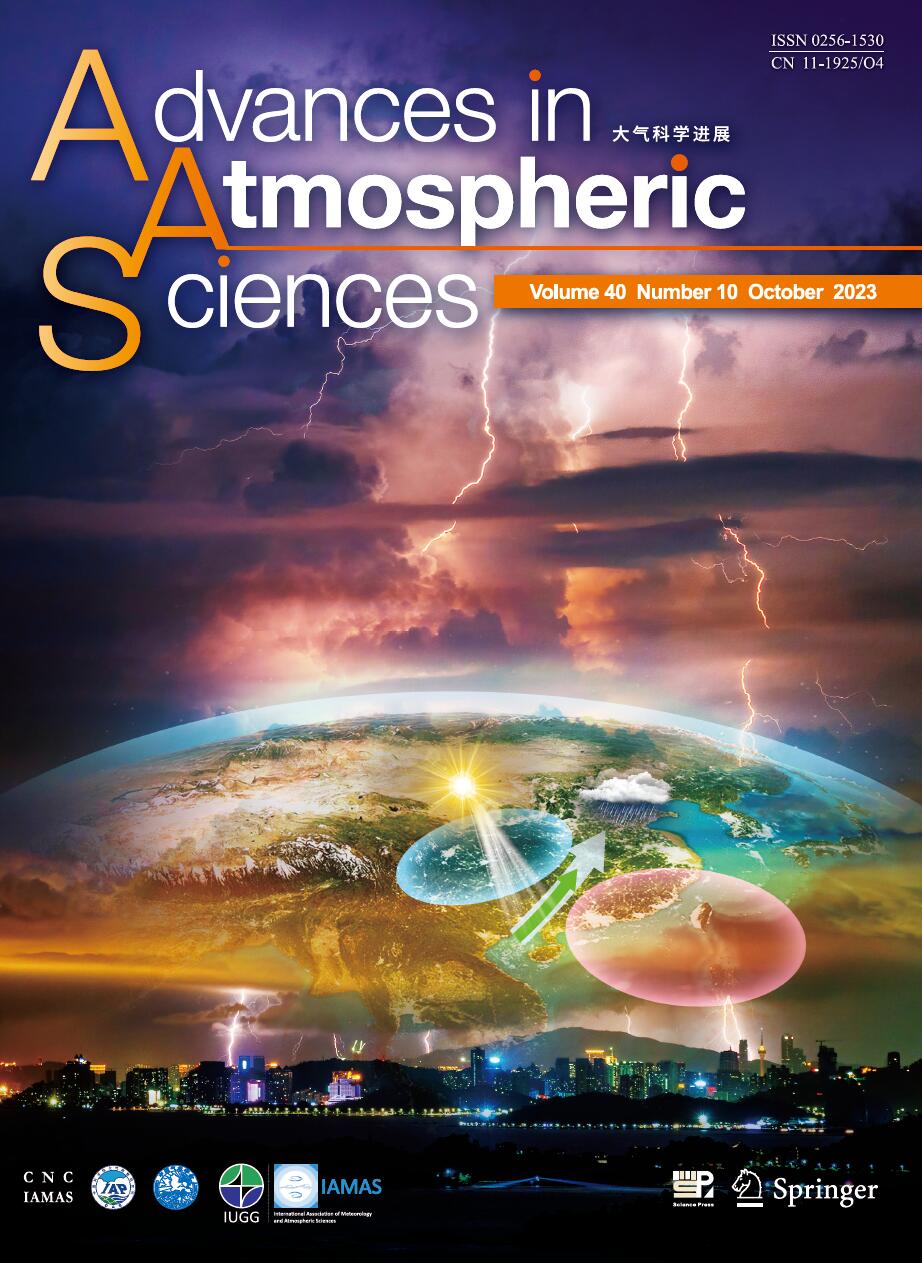| [1] |
Yadi LI, Xichen LI, Juan FENG, Yi ZHOU, Wenzhu WANG, Yurong HOU,
2024: Uncertainties of ENSO-related Regional Hadley Circulation Anomalies within Eight Reanalysis Datasets, ADVANCES IN ATMOSPHERIC SCIENCES, 41, 115-140.
doi: 10.1007/s00376-023-3047-0
|
| [2] |
LI Tao, ZHENG Xiaogu, DAI Yongjiu, YANG Chi, CHEN Zhuoqi, ZHANG Shupeng, WU Guocan, WANG Zhonglei, HUANG Chengcheng, SHEN Yan, LIAO Rongwei,
2014: Mapping Near-surface Air Temperature, Pressure, Relative Humidity and Wind Speed over Mainland China with High Spatiotemporal Resolution, ADVANCES IN ATMOSPHERIC SCIENCES, 31, 1127-1135.
doi: 10.1007/s00376-014-3190-8
|
| [3] |
YU Lejiang, ZHANG Zhanhai, ZHOU Mingyu, Shiyuan ZHONG, Donald LENSCHOW, Hsiaoming HSU, WU Huiding, SUN Bo,
2010: Validation of ECMWF and NCEP--NCAR Reanalysis Data in Antarctica, ADVANCES IN ATMOSPHERIC SCIENCES, 27, 1151-1168.
doi: 10.1007/s00376-010-9140-1
|
| [4] |
CHEN Linling, Ola M. JOHANNESSEN, WANG Huijun, Atsumu OHMURA,
2011: Accumulation over the Greenland Ice Sheet as Represented in Reanalysis Data, ADVANCES IN ATMOSPHERIC SCIENCES, 28, 1030-1038.
doi: 10.1007/s00376-010-0150-9
|
| [5] |
Alexey V. ELISEEV, Igor I. MOKHOV, Konstantin G. RUBINSTEIN, Maria S. GUSEVA,
2004: Atmospheric and Coupled Model Intercomparison in Terms of Amplitude-Phase Characteristics of Surface Air Temperature Annual Cycle, ADVANCES IN ATMOSPHERIC SCIENCES, 21, 837-847.
doi: 10.1007/BF02915586
|
| [6] |
John ABBOT, Jennifer MAROHASY,
2012: Application of Artificial Neural Networks to Rainfall Forecasting in Queensland, Australia, ADVANCES IN ATMOSPHERIC SCIENCES, 29, 717-730.
doi: 10.1007/s00376-012-1259-9
|
| [7] |
Chunlei LIU, Yazhu YANG, Xiaoqing LIAO, Ning CAO, Jimmy LIU, Niansen OU, Richard P. ALLAN, Liang JIN, Ni CHEN, Rong ZHENG,
2022: Discrepancies in Simulated Ocean Net Surface Heat Fluxes over the North Atlantic, ADVANCES IN ATMOSPHERIC SCIENCES, 39, 1941-1955.
doi: 10.1007/s00376-022-1360-7
|
| [8] |
XU Yongfu, LI Yangchun, and CHU Min,
2013: A Global Ocean Biogeochemistry General Circulation Model and its Simulations, ADVANCES IN ATMOSPHERIC SCIENCES, 30, 922-939.
doi: 10.1007/s00376-012-2162-0
|
| [9] |
BUHE Cholaw, Ulrich CUBASCH, LIN Yonghui, JI Liren,
2003: The Change of North China Climate in Transient Simulations Using the IPCC SRES A2 and B2 Scenarios with a Coupled Atmosphere-Ocean General Circulation Model, ADVANCES IN ATMOSPHERIC SCIENCES, 20, 755-766.
doi: 10.1007/BF02915400
|
| [10] |
Deniz BOZKURT, David H. BROMWICH, Jorge CARRASCO, Keith M. HINES, Juan Carlos MAUREIRA, Roberto RONDANELLI,
2020: Recent Near-surface Temperature Trends in the Antarctic Peninsula from Observed, Reanalysis and Regional Climate Model Data, ADVANCES IN ATMOSPHERIC SCIENCES, 37, 477-493.
doi: 10.1007/s00376-020-9183-x
|
| [11] |
Liu Huaqiang, Qian Yongfu, Zheng Yiqun,
2002: Effects of Nested Area Size upon Regional Climate Model Simulations, ADVANCES IN ATMOSPHERIC SCIENCES, 19, 111-120.
doi: 10.1007/s00376-002-0038-4
|
| [12] |
Yuan Zhuojian, Wang Tongmei, He Haiyan, Luo Huibang, Guo Yufu,
2000: A Comparison between Numerical Simulations of Forced Local Hadley (Anti-Hadley) Circulation in East Asian and Indian Monsoon Regions, ADVANCES IN ATMOSPHERIC SCIENCES, 17, 538-554.
doi: 10.1007/s00376-000-0017-6
|
| [13] |
Huang Ruixin, Jin Xiangze, Zhang Xuehong,
2001: An Oceanic General Circulation Model in Pressure Coordinates, ADVANCES IN ATMOSPHERIC SCIENCES, 18, 1-22.
doi: 10.1007/s00376-001-0001-9
|
| [14] |
Zhang Xuehong, Liang Xinzhong,
1989: A Numerical World Ocean General Circulation Model, ADVANCES IN ATMOSPHERIC SCIENCES, 6, 44-61.
doi: 10.1007/BF02656917
|
| [15] |
Jiang Weimei, Wang Xuemei,
1996: A 2-D Non-local Closure Model for Atmospheric Boundary Layer Simulations, ADVANCES IN ATMOSPHERIC SCIENCES, 13, 169-182.
doi: 10.1007/BF02656860
|
| [16] |
S. PANCHEV, T. SPASSOVA,
2005: Simple General Atmospheric Circulation and Climate Models with Memory, ADVANCES IN ATMOSPHERIC SCIENCES, 22, 765-769.
doi: 10.1007/BF02918720
|
| [17] |
XU Zhifang, GE Wenzhong, DANG Renqing, Toshio IGUCHI, Takao TAKADA,
2003: Application of TRMM/PR Data for Numerical Simulations with Mesoscale Model MM5, ADVANCES IN ATMOSPHERIC SCIENCES, 20, 185-193.
doi: 10.1007/s00376-003-0003-x
|
| [18] |
REN Rongcai, WU Guoxiong, Ming CAI, YU Jingjing,
2009: Winter Season Stratospheric Circulation in the SAMIL/LASG General Circulation Model, ADVANCES IN ATMOSPHERIC SCIENCES, 26, 451-464.
doi: 10.1007/s00376-009-0451-z
|
| [19] |
RAO Jian, REN Rongcai, YANG Yang,
2015: Parallel Comparison of the Northern Winter Stratospheric Circulation in Reanalysis and in CMIP5 Models, ADVANCES IN ATMOSPHERIC SCIENCES, 32, 952-996.
doi: 10.1007/s00376-014-4192-2
|
| [20] |
Zhou Guangqing, Zeng Qingcun,
2001: Predictions of ENSO with a Coupled Atmosphere-Ocean General Circulation Model, ADVANCES IN ATMOSPHERIC SCIENCES, 18, 587-603.
doi: 10.1007/s00376-001-0047-8
|















 AAS Website
AAS Website 
 AAS WeChat
AAS WeChat 
 DownLoad:
DownLoad: